DESIGN FC ECONOMY
Page 74

Page 75
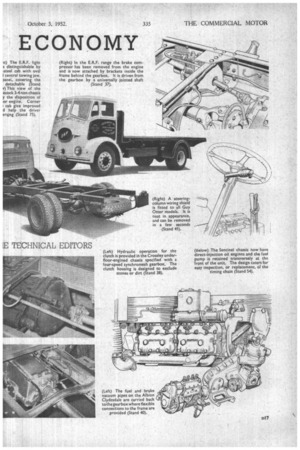
Page 76
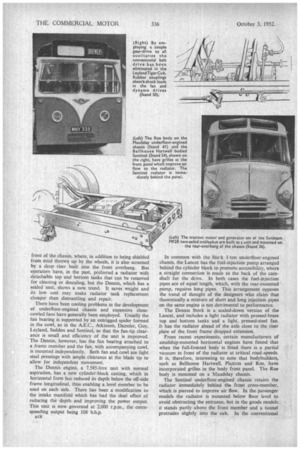
Page 77
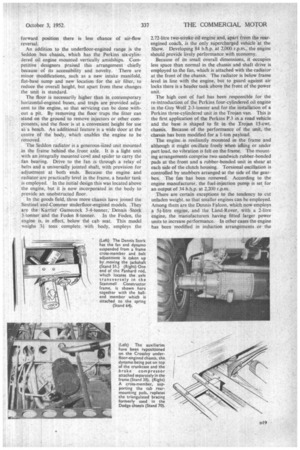
Page 78
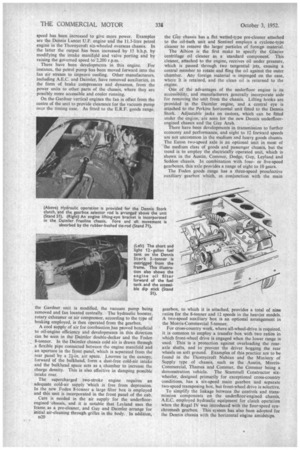
Page 81
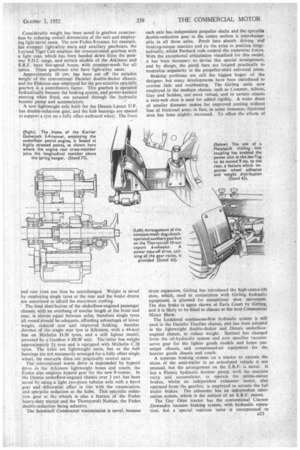
Page 82
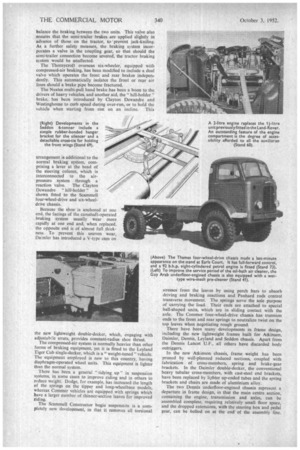
If you've noticed an error in this article please click here to report it so we can fix it.
WHILST vehicles are still being developed specifically for overseas requirements, the new models at Earls Court emphasize a tendency to build lighter chassis for the home market, which will cost less to buy and reduce fuel bills. Rising costs and penal taxation in this country are making the powerful, but heavy, goods and passenger models expensive in fuel and tyres, and the present demand is for lighter and more economical models.
The heavier type has not been superseded, because in the passenger field in this country it is required for coach operation and for crush-load single-deckers. The increased fuel price has broadened the scope of the small oil engine and its adoption in 1-ton and 2-3-ton chassis has met with a good reception at the Show, indicating that there will be a fair demand both at home and overseas.
In the goods field there is a trend towards light 7-8-ton oilers as additituns to ranges which have formerly catered only for maximum-load requirements. Although at present there is a small number of the lighter type available, it is apparent that the 7-ton petrol-engined chassis will soon have serious competition.
With the exception of the Karrier Gamecock, which replaces an existing type, the new models introduced at the Show are additions to existing ranges. Apart from modifications to improve performance, there have been few alterations made to the standard products in the past two years.
The Daimler double-decker, which complete weighs 1 ton 12 cwt. less than a Freeline underfloor-engined chassis equipped with a crush-load single-deck body, is an outstanding contribution to the quest for lighter buses. Atkinson, Dennis and Leyland have attacked weight in underfloor-engined chassis and 44-seat buses of this type are shown with registered weights of 51-54 tons. The Harrington chassisless single-decker holds the record, weighing only 4 tons 13 cwt.
In the goods range, Dodge, E.R.F. and Foden have produced 7-8-tonners employing light chassis for gross loads of 104-11 tons, and newcomers in the oil-engined class include the Dennis Stork 3-tonner and Trojan 1-tonner. The Wolf 2-3-tonner has been reintroduced in the Guy range, the Perkins P4 engine being an alternative to the petrol engine.
Weight has been reduced generally by pruning the frame and component parts, enabling lighter springs and smaller tyres to be employed, so that a comparatively D16 small engine is sufficient to maintain the high acceleration standard set by the large-engined contemporaries. Such has been the case of the Leyland Tiger Cub. This is equipped with a horizontal version of the Comet 90 b.h.p. oil engine, which has the improvement of a bobweight-type automatic injection-advance for the fuelpump timing.
This unit is remarkably clean in its construction, because there are no belt-driven auxiliaries and few external fuel, lubrication, water or brake-connection pipes. The fuel pump is mounted above the cylinder block, with short pipes to the injectors, and the water pump and brake air compressor are attached to the front of the timing case for a straightforward gear drive. Another detail making for trouble-free operation is the fan and dynamo drive, which has been neatened by employing a small auxiliary gear in place of the conventional belt drive.
There is a direct-drive shaft between the front of the crankshaft and the gear case and the shafts linking the fan and dynamo to the gears are rubber-cushioned to absorb the shock-load during rapid acceleration. This simple arrangement has dispensed entirely with the conventional belt drive, which normally requires attention for adjustment or replacement. Another feature of the Leyland engine is a Simms all-pneumatic-operated fuelinjection pump, which is mounted at 15 degrees to the horizontal. A development in Leyland underfloorengined practice is to put the radiator ahead of the front axle, a position which has been decided by the arrangement of the gear drive.
The Dennis Lancet U.F. chassis, a new contender in the lightweight class, is another underfloor-engined model with the radiator mounted between the axle and front of the chassis, where, in addition to being shielded from mud thrown up by the wheels, it is also screened by a deep riser built into the front overhang. Bus operators have, in the past, preferred a radiator with detachable top and bottom tanks that cart be removed for cleaning or descaling, but the Dennis, which has a sealed unit, shows a new trend. It saves weight and its low cost may make radiator tank replacement cheaper than dismantling and repair.
There have been cooling problems in the development of underfloor-engined chassis and expensive closecowled fans have generally been employed. Usually the fan bearing is supported by an outrigged spider formed in the cowl, as in the A.E.C., Atkinson, Daimler, Guy, Leyland, Seddon and Sentinel, so that the fan-tip clearance is small and efficiency of the unit is improved. The Dennis, however, has the fan bearing attached to a frame member and the fan, with accompanying cowl, is mounted independently. Both fan and cowl are light steel pressings with ample clearance at the blade tip to allow for independent movement.
The Dennis engine, a 7.585-litre unit with normal aspiration, has a new cylinder-block casting, which in horizontal form has reduced its depth below the off-side frame longitudinal, thus enabling a level member to be used on each side. There has been a modification to the intake manifold which has had the dual effect of reducing the depth and improving the power output. This unit is now governed at 2,000 r.p.m., the corresponding output being 108 b.h.p. In common with the Stolc 3-ton underfloor-engined chassis, the Lancet has the fuel-injection pump arranged behind the cylinder block to promote accessibility, where a straight connection is made to the back of the camshaft for the drive. In both cases the fuel-injection pipes are of equal length, which, with the rear-mounted pump, requires long pipes. This arrangement opposes the trend of thought of the designers who claim that theoretically a mixture of short and long injection pipes on the same engine is not detrimental to performance.
The Dennis Stork is a scaled-down version of the Lancet, and includes a light radiator with pressed-brass top and bottom tanks and a light, pressed-steel fan. It has the radiator ahead of the axle close to the riser plate of the front frame dropped extension.
From recent experiments, certain manufacturers of amidship-mounted horizontal engines have found that when the full-fronted body is fitted there is a partial vacuum in front of the radiator at critical road .speeds. It is, therefore, interesting to note that bodybuilders, such as Bellhouse Hartwell, Plaxton and Roe, have incorporated grilles in the body front panel. The Roe body is mounted on a Maudslay chassis.
The Sentinel underfloor-engined chassis retains the radiator immediately behind the front cross-member, which is pierced to improve air flow. In the passenger models the radiator is mounted below floor level to avoid obstructing the entrance, but in the goods models it stands partly above the front member and a tunnel protrudes slightly into the cab. In the conventional forward position there is less chance of air-flow reversal.
An addition to the underfloor-engined range is the Seddon bus chassis, which has the Perkins six-cylindered oil engine mounted vertically amidships. Competitive designers praised this arrangement chiefly because of its accessibility and novelty. There are minor modifications, such as a new intake manifold, flat-base sump and new location for the air filter, to reduce the overall height, but apart from these changes the unit is standard.
The floor is necessarily higher than in contemporary horizontal-engined buses, and traps are provided adjacent to the engine, so that servicing can be done without a pit. By removing the floor traps the fitter can stand on the ground to remove injectors or other components, and the floor is at a convenient height for use as a bench. An additional feature is a wide door at the centre of the body, which enables the engine to be removed.
The Seddon radiator is a generous-Sized unit mounted in the frame behind the front axle. It is a light unit with an integrally mounted cowl and spider to carry the fan bearing. Drive to the fan is through a relay of belts and a universally jointed shaft, with provision for adjustment at both ends. Because the engine and radiator are practically level in the frame, a header tank is employed. In the initial design this was located above the engine, but it is now incorporated in the body to provide an unobstructed floor.
In the goods field, three more chassis have joined the Sentinel and.Commer underfloor-engined models. .They are the Karrier Gamecock 3-4-former, Dennis -Stork 3-tonner and the Foden 8-tonner. In the Foden, the engine is, in effect, below the cab seat. This model weighs 34tons complete with body, employs the 2.72-litre two-stroke oil engine and, apart from the rearengined coach, is the only supercharged vehicle 'at the Show. Developing 84 b.h.p. at 2,000 r.p.m., the engine should provide lively performance with economy. Because of its small overall dimensions, it occupies less space than normal in the chassis and shaft drive is employed to the fan, which is attached with the-radiator at the front of the chassis. The radiator is below frame level in line with the engine, but to guard against air locks there is a header tank above the front of the power unit.
The high cost of fuel has been responsible for the re-introduction of the Perkins four-cylindered oil engine in the Guy Wolf 2-3-tonner and for the installation of a Perkins three-cylindered unit in the Trojan van. This is the first application of the Perkins P.3 in a road vehicle and the base is shaped to fit in the Trojan 15-cwt. chassis. Because of the performance of the unit, the chassis has been modified for a 1-ton payload.
The engine is resiliently mounted in the frame and although it might oscillate freely when idling or under part load, no vibration is felt on the frame. The mounting arrangements comprise two sandwich rubber-bonded pads at the front and a rubber-bonded unit in shear at each side of the clutch housing. Torsional oscillation is controlled by snubbers arranged at the side of the gearbox. The fan has been removed. According to the engine manufacturer, the fuel-injection pump is set for an output of 34 b.h.p. at 2,200 r.p.m.
There are certain exceptions to the tendency to cut unladen weight, so that smaller engines can be employed Among them are the Dennis Falcon, which now employs a 5+-litre engine, and the Land-Rover, with a 2-litre engine, the manufacturers having fitted larger power units to increase performance. In other cases the engine has been modified in induction arrangements or the speed has been increased to give more powcr. Examples arc the Dennis Lancet U.F. engine and the 11.3-litre petrol engine in the Thornycroft six-wheeled overseas chassis. In the latter the output has been increased by 15 b.h.p. by modifying the intake manifold and valve porting and by raising the governed speed to 2,200 r.p.m.
There have been developments in this engine. For instance, the petrol pump has been moved forward into the fan air stream to improve cooling. Other manufacturers, including A.E.C. and Daimler, have removed auxiliaries, in the form of brake compressors and dynamos, from the power units to other parts of the chassis, where they are possibly more accessible and cooler running.
On the Gardner vertical engines the fan is offset from the centre of the unit to provide clearance for the vacuum pump over the timing case. As fitted to the E.R.F. goods range, the Gardner unit is modified, the vacuum pump being removed and fan located centrally. The hydraulic booster, rotary exhauster or air compressor, according to the type of braking employed, is then operated from the gearbox.
A cool supply of air for combustion has proved beneficial to oil-engine efficiency and developments in this direction can be seen in the Daimler double-decker and the Foden 8-tanner. In the Daimler chassis cold air is drawn through . a flexible pipe connected between the engine manifold and an aperture in the front panel, which is separated from the rear panel by a 21-in, air space. Louvres in the canopy, forward of the bulkhead, form a dust-free cold-air intake and the bulkhead space acts as a chamber to increase the charge density. This is also effective in damping possible intake roar.
The supercharged two-stroke engine requires an adequate cold-air supply 'which is free from depression. In the new Foden 8-tonner a large filter box is employed and this unit is incorporated in the front panel of the cab.
Care is needed in the air supply for the underfloorengined chassis, and it is notable that Leyland uses the frame, as a pre-cleaner, and Guy and Daimler arrange for initial air-cleaning through grilles in the body., In addition, D20
the du), chassis has a flat wetted-type pre-cleaner attached to the oil-bath unit and Sentinel employs a cyclone-type cleaner to remove the larger particles of foreign material.
The Albion is the first make to specify the Glacier centrifuge oil cleaner as a standard component. This cleaner, attached to the engine, receives oil under pressure, which is passed "through two tangential jets, causing a central member to rotate and fling the oil against the outer chamber. Any foreign material is impinged on the case, where it is retained, and the clean oil is returned to the engine.
One of the advantages of the underfloor engine is its accessibility, and manufacturers generally incorporate aids for removing the unit from the chassis. Lifting hooks are provided in the Daimler engine, and a central eye is attached to the Perkins horizontal unit fitted to the Dennis Stork. Adjustable jacks on castors, which can be fitted under the engine, are seen for the new Dennis underfloorengined chassis and the Guy Arab.
There have been developments in transmission to further economy and performance, and eight to 12 forward speeds are not uncommon in the medium and heavy goods chassis. The Eaton two-speed axle is an optional unit in most of the medium class of goods and passenger chassis, but the trend is to employ the electrically operated unit, which is shown in the Austin, Commer, Dodge, Guy, Leyland and Seddon chassis. In combination with fouror five-speed gearboxes, this axle provides a range of eight to 10 gears.
The Foden goods range has a three-speed preselective auxiliary gearbox which, In conjunction with the main gearbox, to which it is attached, provides a total of nine ratios for the 8-tonner and 12 speeds in the heavier models. A two-speed auxiliary box is an optional arrangement in the Morris-Commercial 5-tonner.
For cross-country work, where all-wheel-drive is required, it is common to employ a transfer box with two ratios in which front-wheel drive is engaged when the lower range is used. This is a protection against overloading the rearaxle shafts, and to prevent the driver bogging the rear wheels on soft ground. Examples of this practice are to be found in the Thornycroft Nubian and the Ministry of Supply type of chassis, such as the Austin, MorrisCommercial, Thames and Commer, the Commer being a demonstration vehicle. The Scarnmell Constructor sixwheeler, designed primarily for exceptional cross-country conditions, has a six-speed main gearbox and separate two-speed transposing box, but front-wheel drive is selective.
To simplify the linkage between the controls and transmission components on the underfloor-engined chassis, A.E.C. employed hydraulic equipment for clutch operation when the Regal IV was introduced with the four-speed synchromesh gearbox. This system has also been adopted for the Dennis chassis with the horizontal engine amidships. Considerable weight has been saved in gearbox construction by reducing overall dimensions of the unit and employing light-metal cases. The new Foden 8-tonner, for example, has compact light-alloy main and auxiliary gearboxes, the Leyland Tiger Cub employs the constant-mesh gearbox with a light case, which has been handed down from the postwar P.D.2 range, and certain models of the Atkinson and E.R.F. have five-speed boxes, with constant-mesh for all ratios. These gearboxes also have light-alloy cases.
Approximately 10 cwt. has been cut off the unladen weight of the conventional Daimler double-decker chassis, and the Elektron case employed for the pre-selective epicyclic gearbox is a contributory factor. This gearbox is operated hydraulically because the braking system, and power-assisted steering when fitted, are actuated through the hydraulic booster pump and accumulators.
A new lightweight axle built for the Dennis Lancet U.F. has double-reduction gear, and the hub bearings are spaced to support a tyre on a fully offset outboard wheel. The front
and rear rims can thus be interchanged. Weight is saved by employing single tyres at the rear and the brake drums are uncovered to afford the maximum cooling.
The load distribution of the underfloor-engined passenger chassis, with an overhang of similar length at the front and rear, is almost equal between axles, therefore single tyres all round should be adequate, affording advantages of lower weight, reduced cost and improved braking. Another devotee of the single rear tyre is Atkinson, with a 44-seat bus on Michelin D.20 tyres, and a still lighter model, powered by a Gardner 4 HLW unit. The latter bus weighs approximately 5f tons and is equipped with Michelin C.20 tyres. The axles are lightweight units, but as the hub bearings are not necessarily arranged for a fully offset single wheel, the rear-axle discs are practically central nave.
The' conventional worm drive is superseded by hypoid drive in the Atkinson lightweight buses and coach; the Foden also employs hypoid gear for the new 8-tonner. In the Dennis underfloor-engined chassis over 3 cwt. has been saved by using a light two-piece tubular axle with a bevel gear and differential offset in line with the transmission, and epicyclic reduction at the hubs. This epicyclic reduction gear at the wheels is also a feature of the Foden heavy-duty tractor and the Thomycroft Nubian, the Foden double-reduction being selective.
The Scammell Constructor transmission is novel, because each axle has independent propeller shafts and the epicyclic double-reduction gear in the centre section is interchangeable in all three axles. Perch bars absorb driving and braking-torque reaction and tic the axles in position longitudinally, whilst Panhard rods control the transverse forces. With the exceptional articulation visualized for this model, it has been necessary to devise this special arrangement, and by design, the perch bars are located practically to neutralize angularity in the propeller-shaft universal joints.
Braking problems are still the biggest bogey of the designer, but many developments have been introduced to combat fade and overheating. The Girling units now employed in the medium chassis, such as Commer, Albion, Guy and Seddon, are more robust, and in certain chassis a twin-web shoe is used for added rigidity. A wider drum of smaller diameter makes for improved cooling without loss of frictional area; in fact, in some instances, frictional area has been slightly increased. To offset the effects of drum expansion, Girling has introduced the high-centre-lift shoe, which, used in conjunction with Girling hydraulic equipment, is planned for exceptional shoe movement. The disc brake is again shown at Earls Court by Girling, and it is likely to be fitted to chassis at the next Commercial Motor Show.
The Lockheed continuous-flow hydraulic system is still used in the Daimler Freeline chassis, and has been adopted in the lightweight double-decker and Dennis underfloorengined chassis, to reduce weight. Sentinel has changed from the all-hydraulic system and now specifies vacuumservo gear for the lighter goods models and home passenger chassis, and compressed-air equipment for the heavier goods chassis and coach. • A separate braking system on a tractor to operate the shoes of the semi-trailer in an articulated vehicle is not unusual, but the arrangement on the E.R.F. is novel. It has a Plessey hydraulic booster pump, with the reaction valve and accumulator, to operate the prime-mover brakes, whilst an independent exhauster motor, also operated from the gearbox, is employed to actuate the full trailer brakes. The exhauster has an independent lubrication system, which is the subject of an E.R.F. patent_ The Guy Otter tractor has the conventional Clayton Dewandre vacuum braking system, with hydraulic operation, but a special reaction valve is incorporated to balance the braking between the two units. This valve also ensures that the semi-trailer brakes are applied slightly in advance of those on the tractor, to prevent jack-knifing. As a further safety measure, the braking system incorporates a valve in the coupling gear, so that should the semi-trailer connection become severed, the tractor braking system would be unaffected.
The Thornycroft overseas six-wheeler, equipped with compressed-air braking, has been modified to include a dual valve which operates the front and rear brakes indepen, dently. This automatically isolates the front or rear air lines should a brake pipe become fractured.
The Ncates multi-pull hand brake has been a boon to the drivers of heavy vehicles, and another aid, the " hill-holder" brake, has been introduced by Clayton Dewandre and Westinghouse to curb speed during over-run, or to hold the vehicle when starting from rest on an incline. This arrangement is additional to the normal braking system, comprising a lever at the head of the steering column, which is interconnected to the airpressure system through a reaction valve. The Clayton Dewandre " hill-holder " is shown fitted to the Scammell four-wheel-drive and six-wheeldrive chassis.
Because the shoe is anchored at one end, the facings of the camshaft-operated braking system usually wear more rapidly at one end and, when replaced, the opposite end is of almost full thickness. To prevent this uneven wear, Daimler has introduced a V-type cam on the new lightweight double-decker, which, engaging with adjustable struts, provides constant-radius shoe thrust.
The compressed-air system is normally heavier than other forms of braking equipment, yet it is fitted to the Leyland Tiger Cub single-decker, which is a" weight-tuned" vehicle. The equipment employed is new to this country, having diaphragm-operated wheel units. This equipment is lighter than the normal system.
There has been, a general "tidying up" in suspension systems, in some cases to improve riding and in others to reduce weight. Dodge, for example, has increased the length of the springs on the tipper and long-wheelbase models, whereas Commer vehicles are equipped with springs which have a larger number of thinner-section leaves for improved riding.
The Scammell Constructor bogie suspension is a completely new development, in that it removes all torsional stresses from the leaves by using perch :bars to absorb driving and braking reactions and Panhard rods control transverse movement. The springs serve the sole purpose of carrying the load. Their ends are attached to special ball-shaped units, which are in sliding contact with the axle. The Commer four-wheel-drive chassis has trunnion ends to the front and rear springs to neutralize twist on the top leaves when negotiating rough ground.
There have been many developments in frame design, including the new lightweight frames built for Atkinson, Daimler, Dennis, Leyland and Seddon chassis. Apart from the Dennis Lancet U.F., all others have discarded body outriggers.
In the new Atkinson chassis, frame weight has been pruned by well-planned reduced sections, coupled with fabrication of cross-members, spring and brake-gear brackets. in the Daimler double-decker, the conventional heavy tubular cross-members, with cast-steel end brackets, have been replaced by lighter up-ended tubes and the spring brackets and chairs are made of aluminium alloy.
The two Dennis underfloor-engined chassis represent a departure in frame design, in that the main centre section, containing the engine, transmission and axles, can be assembled complete, requiring relatively small floor space, and the dropped extensions, with the steering box and pedal gear, can be bolted on at the end of the assembly line.




















































































































































